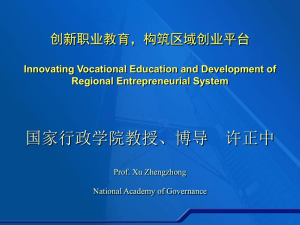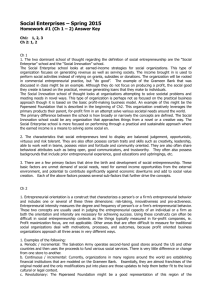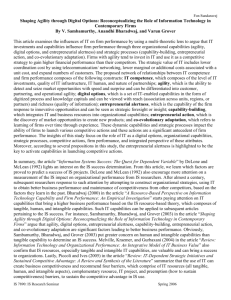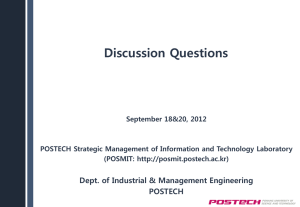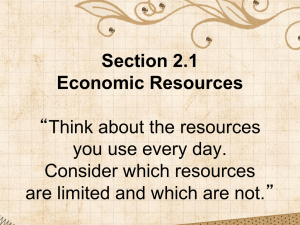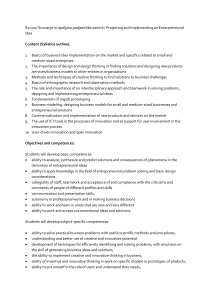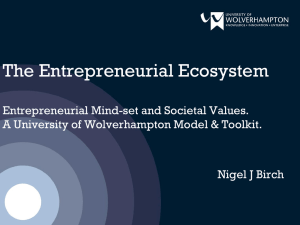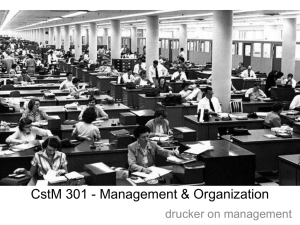Creativity & Decision Making 620:480:01
advertisement
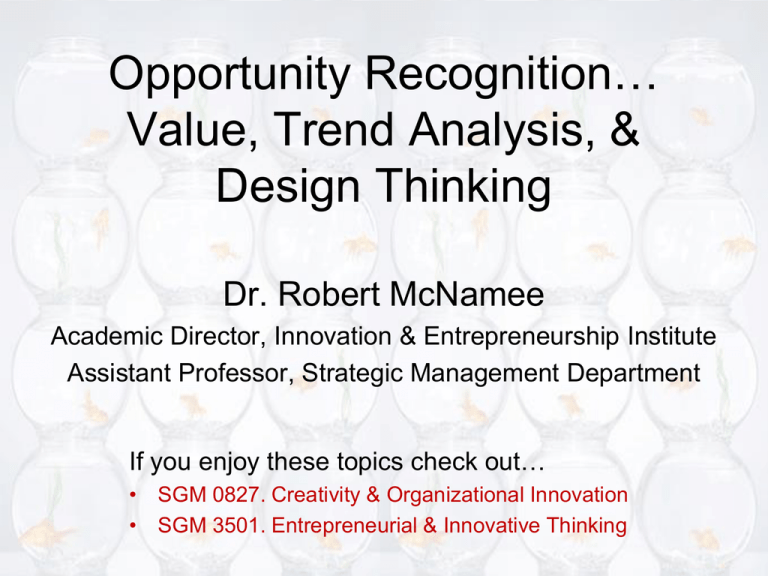
Opportunity Recognition… Value, Trend Analysis, & Design Thinking Dr. Robert McNamee Academic Director, Innovation & Entrepreneurship Institute Assistant Professor, Strategic Management Department If you enjoy these topics check out… • SGM 0827. Creativity & Organizational Innovation • SGM 3501. Entrepreneurial & Innovative Thinking What do you sell?? • Companies sell products / services • Companies [should] create / provide / sell value!! – Understanding how your company creates value, and looking for ways to add more value, are critical elements in developing a competitive strategy. – Michael Porter discussed this in his influential 1985 book "Competitive Advantage," in which he first introduced the concept of the value chain. – Focuses on systems and how inputs are changed into the outputs purchased by consumers What is Value? • Value (customer / consumer POV) – – – – What does s/he do and need? What problems does s/he need to solve? What improvements does s/he look for? What does s/he value? vs. • Value is subjective… vs. Discussion – Examples of Value • Automotive Industry – What value is provided by a car? – Get you from place A to place B… • “in style”… • reliably & safely… • maybe with a number of other people or lots of stuff… – Maybe while giving you an exciting “driving experience” or entertaining you on the way… – Creates a semi-private mobile space—a home away from home… • Telecommunication – What value is provided by a mobile phone? – – – – Connects you to others across town / around the world Clear signal / no dropped calls / rapid support Offers entertainment options (“packages”) Simple billing Value Chain Activities A set of activities that an organization carries out to create value for its customers Value Created – Cost to Create that Value = Margin / Profit Think about all the activities that are involved in turning an egg into a chicken sandwich Or cocoa beans into truffles & then into a $25k dessert… $2.36 / kg $2,600 / lb $25,000 Recognizing Opportunities & Generating Ideas Creative idea is a new connection between concepts, methods, outcomes, etc… that provides potential value Opportunity (Probortunity): …for an existing problem/need in a new or improved way …for a new problem/need/opportunity Needs, wants, problems, & challenges Favorable set of circumstances that creates a demand for a new product, service, business, or other innovation An idea-opportunity match offers promise if… Attractive (your idea is better than other options) Durable (the need will be around for a while) Timely (you are in the ‘window of opportunity’) Associated with creating value for consumer / customer (Someone will buy it / delivers substantially more value than corresponding costs) Opportunities vs. Ideas… • You can “kill” an idea but you can never kill an opportunity!!! – If you have identified a valid need (opportunity), this need still remains even if your idea turns out to impractical or unfeasible… – If you have identified an attractive opportunity spend the time to diverge (consider multiple ideas) and evaluate / evolve your ideas. • On the other hand an opportunity is not the same as an innovative idea – beware of flying cars & time machines! – We all know it would be great to have a flying car • Be realistic -- others have identified the opportunity before • We don’t have a cost-effective, technologically-feasible solution – Ask yourself – what makes this solvable now (and by me)? – If you are not sure an idea is technologically / cost feasible… • Either work hard to figure out if it is feasible / practical • Or move on to think about other opportunities ACTIVE SEARCH / PROBLEM SOLVING (e.g., Design Thinking) It has been said that all new ideas come from outside of ourselves Opportunity Recognition ENTREPRENEURIAL ALERTNESS (e.g., Trends) PRIOR KNOWLEDGE + SOCIAL NETWORKS Prior Knowledge & Social Networks (not Facebook) • Strong Ties – Those you know well / see frequently – Often similar to you – Triadic Closure • You get to know the people your close friends know well • Creates tight cliques w/ redundant knowledge • Weak Ties – People you don’t know well / don’t see often – Source of new perspectives, ideas, knowledge (& jobs) – Brokerage > Innovation Opportunity • When a person connect two disconnected networks Entrepreneurial Alertness • Opportunities – Unexpected Occurrences • Unexpected Successes as well as Failures – Incongruities • When things don’t match up (gaps) – Process Needs • When something just does not work • We will look at process innovation (but also products) – Changes in Perception • If you can see things from a different angle you may come up with some unique ideas Drucker: Discipline of Innovation http://mis.postech.ac.kr/class/MEIE780_AdvMIS/2012%20paper/Part1%2 0(Pack1-3)/01_intro/1-2)%20The%20Discipline%20of%20Innovation.pdf Entrepreneurial Alertness • Opportunities – Industry / Market Changes Obvious opportunities are frequently no longer opportunities • Industries and Markets evolve – Demographic Changes • Millenials, Baby Boomers, etc… – New Knowledge / Technologies • Stand on the shoulders of giants (e.g., $9 bike, $50 tablet) • One IMPORTANT take away – Innovation can be systematic and requires hard work – “Know when to research and when to brainstorm” Drucker: Discipline of Innovation http://mis.postech.ac.kr/class/MEIE780_AdvMIS/2012%20paper/Part1%2 0(Pack1-3)/01_intro/1-2)%20The%20Discipline%20of%20Innovation.pdf PEST, PESTLE, etc… • • • • • • Political Economic Social Technological [Legal] [Environmental] These are high level macro trends that affect all industries… http://www.youtube.com/watch?v=YFUMZ_o6l2s Active Problem Solving… Design Thinking • Tim Brown & IDEO… “…imbues the full spectrum of innovation activities with a human-centered design ethos…” “…powered by a thorough understanding, through direct observation, of what people need and want in their lives” How Design Thinking Happens… • “The myth of creative genius is resilient: We believe that great ideas pop fully formed out of brilliant minds, in feats of imagination well beyond the abilities of mere mortals…” • In reality innovation is “…the result of hard work augmented by a creative human-centered discovery process and followed by iterative cycles of prototyping, testing, and refinement. http://www.youtube.com/watch?v=JkHOxyafGpE Design Thinking Mindsets… http://dschool.stanford.edu/wpcontent/uploads/2011/03/BootcampBootleg2010v2SLIM.pdf Ready, Fire, Aim Design Thinking Process

